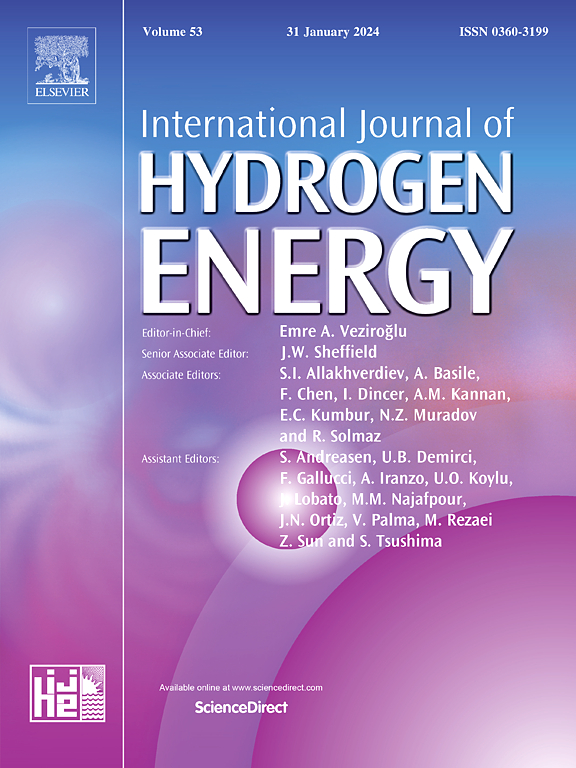Donor-acceptor engineering of NiPc-based covalent organic frameworks for boosting oxygen reduction and hydrogen evolution reactions
IF 8.1
2区 工程技术
Q1 CHEMISTRY, PHYSICAL
引用次数: 0
Abstract
Covalent organic frameworks (COFs), particularly imine-linked COFs, have emerged as viable electrocatalytic materials to promote oxygen reduction reaction (ORR) and hydrogen evolution reaction (HER). However, a slow intramolecular charge transfer significantly limits their electrocatalytic activity. One effective strategy to overcome this drawback involves the introduction of donor-acceptor (D-A) structural units to the imine-linked COFs. Herein, with a donor-acceptor engineering strategy, three novel imine-linked COFs with D-A structural units that serve as efficient ORR/HER bifunctional electrocatalysts have been synthesized using 2,5-thiophenedicarboxaldehyde (TDA), thieno[3,2-b]thiophene-2,5-dicarboxaldehyde (TT) and benzo[1,2-b:3,4-b':5,6-b'']trithiophene-2,5,8-tricarbaldehyde (BTT) as electron donors, and 2,9,16,23-tetraaminophthalocyanine nickel (II) (NiPc) as an electron acceptor (denoted as TDA-NiPc-COF, TT-NiPc-COF and BTT-NiPc-COF). When compared with TDA-NiPc-COF and BTT-NiPc-COF, TT-NiPc-COF exhibits the higher ORR/HER activity thanks to its larger specific surface area, more abundant catalytic sites and stronger intrinsic charge transfer ability. Theoretical calculations have revealed that TT-NiPc-COF has the smallest HOMO-LUMO energy gap and lowest Gibbs free energy values for intermediates on the Ni–N and thiophene-S sites, indicating the fastest charge transfer ability and the most positive catalytic ability for ORR/HER. In addition, a negatively shifted d-band center energy provided by TT-NiPc-COF indicates an optimized adsorption strength of ORR-correlated intermediates, resulting in substantial improvement in ORR activity. This study provides a new insight into the rational design of novel imine-linked COFs with D-A structural units for application in the electrocatalytic field.

基于nipc的共价有机框架的供受体工程促进氧还原和析氢反应
共价有机框架(COFs),特别是亚胺连接的COFs,已成为促进氧还原反应(ORR)和析氢反应(HER)的可行电催化材料。然而,缓慢的分子内电荷转移极大地限制了它们的电催化活性。克服这一缺点的一个有效策略是在亚胺连接的COFs中引入供体-受体(D-A)结构单元。本文采用供体-受体工程策略,以2,5-噻吩二甲醛(TDA)、噻吩[3,2-b]噻吩-2,5-二甲醛(TT)和苯并[1,2-b:3,4-b':5,6-b']三噻吩-2,5,8-三乙醛(BTT)为电子给体,2,9,16,23-四氨基眼青氨酸镍(II) (NiPc)为电子受体(记为TDA-NiPc- cof)为电子受体,合成了三种具有D-A结构单元的新型亚胺连接COFs,作为高效的ORR/HER双功能电催化剂。TT-NiPc-COF和BTT-NiPc-COF)。与TDA-NiPc-COF和BTT-NiPc-COF相比,TT-NiPc-COF由于其更大的比表面积、更丰富的催化位点和更强的内在电荷转移能力,表现出更高的ORR/HER活性。理论计算表明,TT-NiPc-COF在Ni-N和噻吩- s位点上具有最小的HOMO-LUMO能隙和最低的Gibbs自由能值,表明其具有最快的电荷转移能力和最积极的ORR/HER催化能力。此外,TT-NiPc-COF提供的d波段中心能量负移表明ORR相关中间体的吸附强度优化,从而显著提高ORR活性。该研究为合理设计具有D-A结构单元的新型亚胺连接COFs在电催化领域的应用提供了新的见解。
本文章由计算机程序翻译,如有差异,请以英文原文为准。
求助全文
约1分钟内获得全文
求助全文
来源期刊

International Journal of Hydrogen Energy
工程技术-环境科学
CiteScore
13.50
自引率
25.00%
发文量
3502
审稿时长
60 days
期刊介绍:
The objective of the International Journal of Hydrogen Energy is to facilitate the exchange of new ideas, technological advancements, and research findings in the field of Hydrogen Energy among scientists and engineers worldwide. This journal showcases original research, both analytical and experimental, covering various aspects of Hydrogen Energy. These include production, storage, transmission, utilization, enabling technologies, environmental impact, economic considerations, and global perspectives on hydrogen and its carriers such as NH3, CH4, alcohols, etc.
The utilization aspect encompasses various methods such as thermochemical (combustion), photochemical, electrochemical (fuel cells), and nuclear conversion of hydrogen, hydrogen isotopes, and hydrogen carriers into thermal, mechanical, and electrical energies. The applications of these energies can be found in transportation (including aerospace), industrial, commercial, and residential sectors.
 求助内容:
求助内容: 应助结果提醒方式:
应助结果提醒方式:


